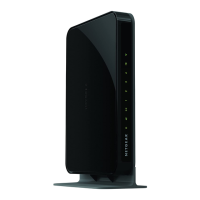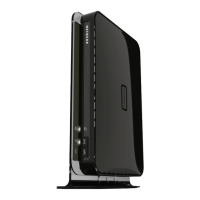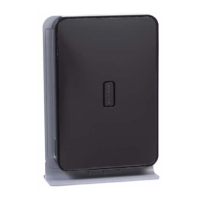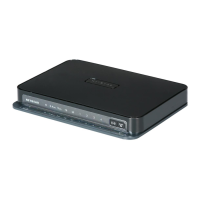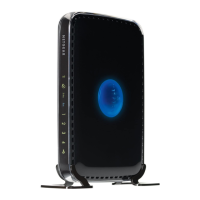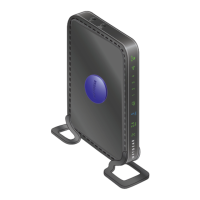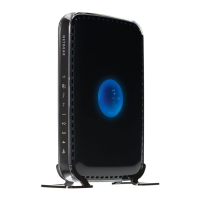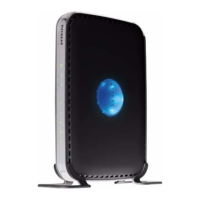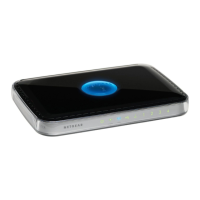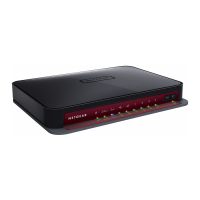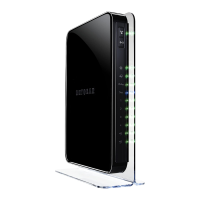Do you have a question about the NETGEAR WNDR3700v4 and is the answer not in the manual?
Details on router box contents and initial setup steps.
Description of router's physical components and indicators.
Explanation of front panel LEDs, icons, and buttons.
Identifies ports and buttons on the router's rear panel.
Details found on the router's bottom label, including credentials.
Instructions for assembling and attaching the router stand.
Guidance on ideal router placement for signal strength.
Step-by-step guide for connecting modem, router, and computer.
Checks router LED status to confirm correct cable connections.
Steps and information needed before router setup.
Explains different router and ISP login credentials.
Accessing router settings via the NETGEAR genie interface.
Instructions for updating router firmware for latest features.
Navigating the basic home screen and its features.
Steps to connect devices using manual or WPS methods.
Information on using genie on smartphones and tablets.
Understanding the main dashboard and its sections.
Configuring basic ISP settings for internet access.
Detailed description of ISP configuration options.
Identifying devices connected to the network.
Configuring content filtering and access restrictions.
Managing USB storage devices connected to the router.
Configuring Wi-Fi network name (SSID) and security.
Explanation of various wireless configuration options.
How to modify wireless network security settings.
Setting up a separate network for visitors.
Understanding the advanced dashboard status information.
Using the wizard to detect and set up internet connection.
Adding WPS-compatible devices easily.
Accessing various setup options like WAN, LAN, QoS.
Configuring Wide Area Network settings like DMZ and MTU.
Exposing a computer to the internet for specific applications.
Adjusting Maximum Transmission Unit for network performance.
Configuring Local Area Network settings like IP and DHCP.
Using the router as a DHCP server for IP address assignment.
Assigning static IP addresses to specific devices.
Prioritizing network traffic for applications and devices.
How to access and share USB drives.
Examples of sharing files and media.
Viewing and editing basic USB storage settings.
Creating and managing shared folders on USB drives.
Configuring workgroups and advanced access methods.
Procedure for safely disconnecting USB storage.
Enabling DLNA/UPnP media streaming from USB devices.
Enhancing security by allowing only specific USB devices.
Connecting to the router's USB drive from a remote computer.
Accessing USB drive files via FTP over the internet.
Preventing access to websites based on keywords.
Blocking specific internet services or ports.
Setting times for blocking internet access or services.
Configuring email alerts for security events.
Updating the router's operating software.
Checking router's hardware, firmware, and connection status.
Monitoring WAN connection status and traffic statistics.
Details on Wi-Fi network names, regions, channels, and modes.
Reviewing records of accessed or blocked websites.
Backing up, restoring, or erasing router settings.
Changing the password for router administration access.
Configuring security questions for password recovery.
Fine-tuning wireless radio settings like transmit power and schedules.
Configuring router as access point or wireless repeater.
Managing inbound traffic rules for servers and applications.
Configuring dynamic domain names and network routes.
Enabling and configuring remote access to router settings.
Managing USB devices and Universal Plug and Play features.
Setting up IPv6 connection types like Auto Detect, Fixed, or PPPoE.
Monitoring and limiting internet traffic volume.
Basic troubleshooting steps and restart order.
Diagnosing issues based on router LED status.
Resolving issues with router login and internet access.
Troubleshooting unsaved settings and incorrect date/time.
Diagnosing wireless connection and signal strength problems.
Details on default router configurations and behavior.
Hardware and performance specifications of the router.
Overview of rules for operating radio devices.
FCC rules, exposure limits, and operation guidelines.
Warnings and instructions regarding RF interference.
Minimum distances for household appliances to reduce interference.
Details on router box contents and initial setup steps.
Description of router's physical components and indicators.
Explanation of front panel LEDs, icons, and buttons.
Identifies ports and buttons on the router's rear panel.
Details found on the router's bottom label, including credentials.
Instructions for assembling and attaching the router stand.
Guidance on ideal router placement for signal strength.
Step-by-step guide for connecting modem, router, and computer.
Checks router LED status to confirm correct cable connections.
Steps and information needed before router setup.
Explains different router and ISP login credentials.
Accessing router settings via the NETGEAR genie interface.
Instructions for updating router firmware for latest features.
Navigating the basic home screen and its features.
Steps to connect devices using manual or WPS methods.
Information on using genie on smartphones and tablets.
Understanding the main dashboard and its sections.
Configuring basic ISP settings for internet access.
Detailed description of ISP configuration options.
Identifying devices connected to the network.
Configuring content filtering and access restrictions.
Managing USB storage devices connected to the router.
Configuring Wi-Fi network name (SSID) and security.
Explanation of various wireless configuration options.
How to modify wireless network security settings.
Setting up a separate network for visitors.
Understanding the advanced dashboard status information.
Using the wizard to detect and set up internet connection.
Adding WPS-compatible devices easily.
Accessing various setup options like WAN, LAN, QoS.
Configuring Wide Area Network settings like DMZ and MTU.
Exposing a computer to the internet for specific applications.
Adjusting Maximum Transmission Unit for network performance.
Configuring Local Area Network settings like IP and DHCP.
Using the router as a DHCP server for IP address assignment.
Assigning static IP addresses to specific devices.
Prioritizing network traffic for applications and devices.
How to access and share USB drives.
Examples of sharing files and media.
Viewing and editing basic USB storage settings.
Creating and managing shared folders on USB drives.
Configuring workgroups and advanced access methods.
Procedure for safely disconnecting USB storage.
Enabling DLNA/UPnP media streaming from USB devices.
Enhancing security by allowing only specific USB devices.
Connecting to the router's USB drive from a remote computer.
Accessing USB drive files via FTP over the internet.
Preventing access to websites based on keywords.
Blocking specific internet services or ports.
Setting times for blocking internet access or services.
Configuring email alerts for security events.
Updating the router's operating software.
Checking router's hardware, firmware, and connection status.
Monitoring WAN connection status and traffic statistics.
Details on Wi-Fi network names, regions, channels, and modes.
Reviewing records of accessed or blocked websites.
Backing up, restoring, or erasing router settings.
Changing the password for router administration access.
Configuring security questions for password recovery.
Fine-tuning wireless radio settings like transmit power and schedules.
Configuring router as access point or wireless repeater.
Managing inbound traffic rules for servers and applications.
Configuring dynamic domain names and network routes.
Enabling and configuring remote access to router settings.
Managing USB devices and Universal Plug and Play features.
Setting up IPv6 connection types like Auto Detect, Fixed, or PPPoE.
Monitoring and limiting internet traffic volume.
Basic troubleshooting steps and restart order.
Diagnosing issues based on router LED status.
Resolving issues with router login and internet access.
Troubleshooting unsaved settings and incorrect date/time.
Diagnosing wireless connection and signal strength problems.
Details on default router configurations and behavior.
Hardware and performance specifications of the router.
Overview of rules for operating radio devices.
FCC rules, exposure limits, and operation guidelines.
Warnings and instructions regarding RF interference.
Minimum distances for household appliances to reduce interference.
| Model | WNDR3700v4 |
|---|---|
| Category | Wireless Router |
| Wireless Standards | IEEE 802.11 a/b/g/n |
| Frequency Band | 2.4 GHz and 5 GHz |
| USB Ports | 1 x USB 2.0 |
| Security | WPA/WPA2-PSK |
| VPN Support | Yes |
| Antenna | Internal |
| Ethernet Ports | 5 x 10/100/1000 Mbps (1 WAN and 4 LAN) |
